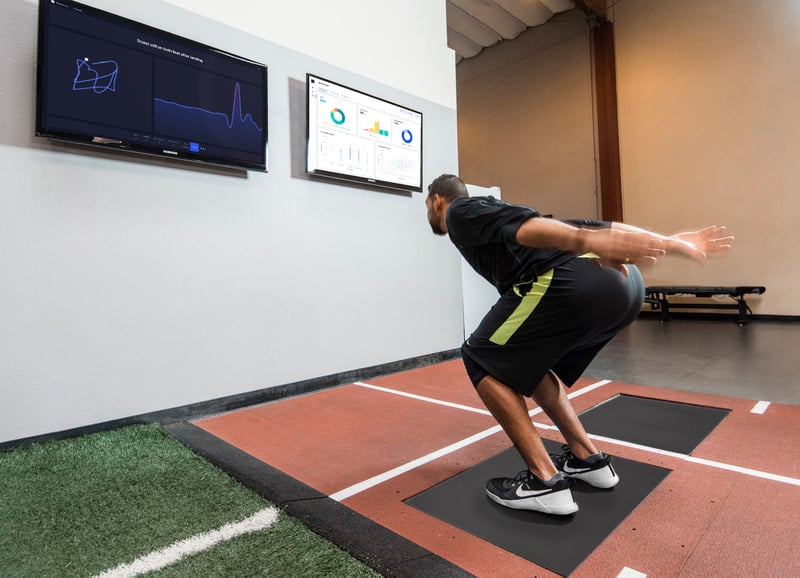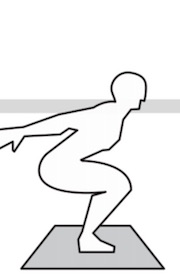
As the Sparta Science blog approaches its tenth year in existence, many different topics relating to human performance have been covered in great depth and re-visited over the past decade. Looking back, it is fun to see the evolution of how the industry has progressed and similarly how our insights have been able to grow with the growth of our training facility, software, and database. Because Sparta has been around for so long, those a bit newer to our blog often have many questions around our company and technology. The different assessments we implement and terminology we use (while simple on the surface) are a result of the research, testing, data collection, discussions, experience, and knowledge from countless individuals over the years.
Those who have been following along have seen some of these evolutions occur in real-time. Most of the questions we get from those who aren’t as familiar with us revolve around our assessments, software, and database; and as an (re)introduction, today we are going to take a step back to do an overview of three concepts that have been dissected in great depth over the years: Load, Explode, and Drive.
The first assessment we began collecting data on years ago was the vertical jump. We have discussed in great depth some of the reasons why the vertical jump makes a great movement assessment, but today we are going to dive more into the different variables that are analyzed within the jump. The main three variables we utilize are average eccentric rate of force development, average relative concentric force, and relative concentric impulse. If those terms are a bit confusing to you, you’re not alone. This is the exact reason we utilize the simpler, “stickier” terminology of Load, Explode, and Drive – respectively. While we are happy to discuss the technical details of the different variables that can be collected from the force plate, it is too narrow of a focus to simply become experts in force-time curve analysis. We are in the business of helping individuals to move better. This simplified terminology relates much better to those who we have the ability to impact, and this we know from experience.
The terms Load, Explode, and Drive we actually used to call Rate, Force, and Time. In fact, we originally focused on just two variables (Rate and Force) but after years of collecting thousands of different variables we found relative concentric impulse, or Time, to be an important contributor to human movement. These terms, while perhaps more “accurate,” resonated much more with academics and scientists than coaches and athletes, and in turn the terms Load, Explode, and Drive became the nomenclature used to describe an individual’s overall results from our jump assessment; termed the Movement Signature™. These variables are reported in T-Scores relative to our 10 year old database to allow for easier interpretation, as the raw values are in different units and it is much harder to identify injury risk thresholds or meaningful change by merely looking at the raw values.
The Movement Signature™ and Sparta software are utilized by sports organizations, military groups, and general populations alike, however much of the language and examples are more focused on athletes as it is much simpler for people to relate and understand these concepts. Agree or disagree with the nomenclature, the fact is this simple change has allowed us to better translate information to the masses to improve transparency, trust, and compliance – and in turn improved outcomes for the individuals we work with.

The ability to generate force quickly and efficiently requires sufficient triple flexion, including anterior chain strength, mobility, and stiffness (quad and ankle). Efficient eccentric strength as well as the ability to absorb eccentric forces effectively are two critical components. These allow for sufficient LOAD, and a more resilient individuals.
The first variable we measure is Average Eccentric Rate of Force Development. This is measured during the downward phase of the jump and is a measure of how quickly an individual is able to produce force or start a movement. We see greater levels of Load often in stronger individuals as they often have a great rate of force development, and also in those that are anterior chain dominant through repetitive movements. Big strong quads and ample ankle range of motion are common traits of active individuals with higher load. Offensive and defensive lineman, baseball and softball catchers, and rugby front row are three types of athletes that commonly assess this way.
A sufficient Load represents the ability to produce force quickly and efficiently. Those with lower Load can suffer because with an inefficient start, force generation must occur in a different way, typically through the over-utilization of momentum. This is often the case with younger and untrained individuals, as well as those with previous knee or ankle (anterior chain) injuries that may alter individual movement mechanics. Like most things, too much is often just as good as too little, as those with higher Load (relative) can also be less efficient and at higher risk of injury because they are unable to dissipate the greater amount of force they create in the beginning of a movement.
With the movements we have seen that help improve Load typically have a few things in common. Most (¼ Squat, Front Squat, 1-Leg Squat) are very anterior chain dominant, and emphasize the ankle joint and quad musculature that are typically well developed in those with high Load. While some (¼ Squat, Back Squat, Bench Press, Deadlift) are typically done with higher intensities as bilateral movements typically more scalable in this way. Improving Load typically doesn’t happen overnight, as improving strength levels and altering joint sequencing require intent and time for adaptation.

The ability to transfer forces effectively requires sufficient musculo-tendinous elasticity, as well as a strong and responsive connection between upper body and lower body segments (core strength and stability). These two qualities describe the EXPLODE variable, and are a prerequisite to minimize weak links in the kinetic chain.
The second variable we measure is Average Relative Concentric Force. This is measured during the upward phase of the jump and is a measure of how effectively an individual is able to transfer force or transition a movement. We see higher Explode often in (you guessed it) “explosive” individuals as they often have great tendinous elasticity, and those with higher levels of relative strength. Skill positions in football and basketball players are often blessed with high levels of Explode as this is often required for reactive acceleration and change of direction abilities.
A sufficient Explode represents the ability to transfer forces efficiently allowing for less wasted energy in movement. Those with lower Explode can suffer because with an inefficient transition (or amortization phase), force is often leaked through the trunk or core in linear and lateral movements. This again is often the case with younger and untrained individuals with poor postural control, previous low back or pelvic injuries, and individuals with poor relative strength levels who have more “non-functional” mass. In athletes that rotate for a living, baseball pitchers for example, this is also common as the transfer of forces occurs through dissociation or torque, not through straight lines. A high Explode can also cause issues as the reliance on tendinous structures especially around the hip can cause pain or injury.
Similar to Load, movements we have seen to help improve Explode have a few common threads. To start, Explode has proven to be a bit more stubborn than either Load or Drive to improve significantly which may be because it is more driven by less modifiable factors like muscle fiber type and musculo-tendinous stiffness. However, movements that require efficient bracing and transfer of force through the trunk such as Deadlift, Suitcase Deadlift, Wood-Chop, and Hang Clean have all been proven as interventions to help improve Explode. Often individuals with high Explode have very little traditional training experience having only just played their sport – this may foreshadow some evidence that jumps, throws, plyometrics, and ballistic training may be critical for improving this variable as well.
Read on: High Explode, Low Explode

The ability to apply forces efficiently requires sufficient triple flexion and extension, including efficient utilization of the upper body in movement. Effective posterior chain mobility (thoracic, shoulder, and hip) and musculo-tendinous compliance are two common characteristics of individuals with sufficient DRIVE, and key contributors to efficient movement.
The final variable that gets represented in an individual’s Movement Signature is the Relative Concentric Impulse or Drive. Like Explode, this variable is measured during the upward phase of the jump, but an impulse is a measure of both magnitude and duration of force. Drive is a measure of how efficiently an individual is able to apply, or prolong force. We see greater levels of Drive often in individuals who utilize greater active ranges of motion in movement as they are able to apply forces for longer, and who are more fluid in their movement. Drive is negatively correlated with Explode and is often viewed as the less important factor to the more “sexy” Explode. However, it is important to understand that our ability to actually apply the force we create and transfer is often a limiting factor in movement efficiency. For example while it would make sense that Explode is highly correlated with sprinting speed, Drive is almost just as highly correlated, with the combination of the two (Explode + Drive) having the greatest predictive ability of sprint speed.

A sufficient Drive represents the ability to apply forces efficiently allowing for better utilization of this energy that has been both created and transferred. One of the main costs of a lower drive is wasted energy that is often seen in the form of fatigue, what looks like an “out of shape” individual is often an inefficient force applier. Another concern with low Drive is a decrease in the dissipation of force and and reciprocal inhibition which often contribute to muscle strain injuries. However, a high Drive (relative) is often the cause of an overuse of momentum (largely from the upper body) in movement as a lack of force generation and transfer requires a longer duration of force application for movement to occur. Like a lower Load and Explode, a higher Drive is common in untrained and younger individuals, as well as endurance athletes and yoga enthusiasts. We have also seen Cross-Fit athletes with high levels of Drive relative to Load and Explode as AMRAP (as many reps as possible) protocols often require more efficient use of momentum versus strength.
Again our Drive interventions typically have a few things in common. The RDL, Overhead Squat, and Split Squat all require greater active ranges of motion and mobility which are key components required to improve the efficiency of force application. Meanwhile the Split Squat and 1-Leg Hip Thrust are posterior chain unilateral movements that are often performed much slower and emphasize activation and relaxation simultaneously. Another extremely common intervention for low Drive individuals is soft tissue manipulation which can have an affect on Drive both acutely and chronically (if performed frequently).
Read on: High Drive, Low Drive
This (not that) brief primer on Load, Explode, and Drive can hopefully serve as a reference for those recently introduced to Sparta and a refresher for those who utilize the software daily. If you browse the pages of this blog you will find countless articles relating to these three movement qualities which we have identified, measured, and studied for over a decade here at Sparta Science. As we continue to learn more based on others research and our own we will continue to evolve while keeping the goal the goal: to help individuals to reduce risk of injury and improve health and performance.